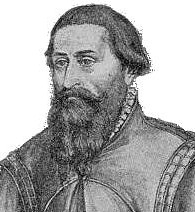Veit Stoss
Veit Stoss | |
|---|---|
 | |
| Born | Before 1450 |
| Died | 20 September 1533 |
| Resting place | St. Johannis cemetery, Nuremberg |
| Known for | Sculpture |
| Movement | Late Gothic, Northern Renaissance |
Veit Stoss (also: Veit Stoß and Stuoss;
.Life
According to the contracts and other official documents written in the fifteenth and sixteenth centuries, Stoss was born in a place pronounced as Horb or Horbn. Most researchers identify this place with Horb am Neckar near Stuttgart in Germany. However, there are artistic traces indicating that Stoss's early education could take place in the modern Switzerland. Moreover, his brother was certainly born in Aarau in northern Switzerland, which suggests that the artist's family lived in the region and that Stoss was rather born in the town of Horben, located 30 km southeast of Aarau[2] His exact date of birth is unknown though it must have been shortly before 1450. Nothing about his life is known for certain before 1473 when he moved to
In Kraków
Veit lived and worked in Kraków for almost twenty years, from 1477–1496. His name is usually polonized as Wit Stwosz.[3] The altar in Kraków was completed in 1489, and was the largest triptych of its time. Like Stoss' other large works, it required a large workshop including specialized painters and gilders.[4] Other important works from Stoss' period in Poland were the tomb of Casimir IV in Wawel Cathedral, the marble tomb of Zbigniew Oleśnicki in Gniezno, and the altar of Saint Stanislaus. The Polish court was more aware of Italian styles than Nuremberg patrons of that time, and some of Stoss' Polish work used Renaissance classical ornament.[5]
During World War II, on the order of Hans Frank – the Governor-General of that region of occupied Poland – the dismantled Altar was shipped to Nazi Germany around 1941. It was rediscovered in 1945 in Bavaria, hidden in the basement of the heavily bombed Nuremberg Castle.[6] The High Altar underwent major restoration work in Poland and was put back in its place at the Basilica ten years later.[3]
Nuremberg
In 1496, Stoss returned to Nuremberg with his wife and eight children. He reacquired his citizenship for three

Despite the prohibition he went to
were unsuccessful.During the period 1515–1520, Veit Stoss received a commission for sculptures by
Veit Stoss was buried at St. Johannis cemetery in Nuremberg.[12] His artistic legacy was continued by his son Stanisław.[13]
In popular culture
Veit Stoss is featured in Judith Weir's opera, The Black Spider. He is one of the singing sculptors in Act 3 Scene 2 inside the Wawel Cathedral. He is shown chiseling at the tomb of King Casimir IV. There is a Polish book (1913) and film (1961) Historia żółtej ciżemki (The story of a yellow crakow)[14] about Veit Stoss in Cracow.
Notes and references
- ^ a b Snyder 1985, p. 309
- ^ Kępiński, Zbigniew (1981). Wit Stwosz. Auriga. pp. 7–9.
- ^ a b Życie i twórczość Wita Stwosza (Life and Art of Wit Stwosz.) Jagiellonian University (in Polish)
- ^ Snyder, 308–309
- ^ "Janusz Kębłowski, Wit Stwosz w Krakowie (Wit Stwosz in Krakow)".
- ^ Kirkpatrick
- ^ Durant, Will (1957). The Reformation. Simon and Schuster: New York. p. 307.
- ^ Snyder, 305
- ISBN 978-3-85002-485-3. Retrieved 25 February 2022.
- ^ Weilandt, Gerhard. Stoß, Veit - Deutsche Biographie (in German). Retrieved 25 February 2022.
- ^ Baxandall
- ^ "St. Johannisfriedhof > Prominente". Evangelisch-Lutherische Friedhofsverwaltung, St.Johannis und St. Rochus. Retrieved 18 January 2018.
- ^ Piltz, Erasmus, ed. (1909). Poland, her people, history, industries, finance, science, literature, art, and social development. London: H. Jenkins Limited. p. 360. Retrieved 18 January 2018.
Among the pupils of this great master who became famous were Stanislaw Stwosz the younger...
- ^ "Story of the Golden Boot" – via www.imdb.com.
Sources
- ISBN 0-300-02829-6.
- Bautz, Traugott, ed. (1996). "Stoss, Veit". Biographisch-Bibliographisches Kirchenlexikon (BBKL) (in German). Vol. 11. Herzberg: Bautz. cols. 1–5. ISBN 3-88309-064-6.
- R. Kahnsitz, ed. (1983). Veit Stoss in Nürnberg. Werke des Meisters und seiner Schule in Nürnberg und Umgebung (catalogue of the exhibition) (in German). Munich.
{{cite book}}: CS1 maint: location missing publisher (link) - Kepinski, Zdzislaw (1981). Veit Stoss (in German). Verlag der Kunst. ISBN 83-221-0138-4.
- Kirkpatrick, Sidney (2010). Hitler's Holy Relics. Simon & Schuster. ISBN 978-1-4165-9062-0.
- Schultz, Ellen, ed. (1986). Gothic and Renaissance Art in Nuremberg. New York: Metropolitan Museum of Art. ISBN 978-0-87099-466-1.
- Skubiszewski, Piotr (1978). "Der Stil des Veit Stoss" (in German). 41 (2). Zeitschrift für Kunstgeschichte: 93–133.
{{cite journal}}: Cite journal requires|journal=(help) - Snyder, James (1985). Northern Renaissance Art: Painting, Sculpture, the Graphic Arts From 1350 to 1575. Prentice-Hall / Harry N. Abrams. ISBN 0-13-623596-4.
Further reading
- Herbermann, Charles, ed. (1913). . Catholic Encyclopedia. New York: Robert Appleton Company.
- Chisholm, Hugh, ed. (1911). . Encyclopædia Britannica (11th ed.). Cambridge University Press.
External links
- Robin Pilch Craren (2012): VEIT STOSS/WIT STWOSZ CONTEXTUALIZED WITHIN THE POLISH TRADITION OF SCULPTURE IN THE LATE FIFTEENTH CENTURY, M A Thesis, fulltext, pictures, 118 pp
- St. Mary's Altar by Veit Stoss, Cracow 2010, detailed videodocument
- Story of the Cracow altarpiece
- Web Gallery of Art: STOSS Veit
- Stoss carving in the Victoria and Albert Museum, London
- Profile of Veit Stoss (Wit Stwosz) at Culture.pl
